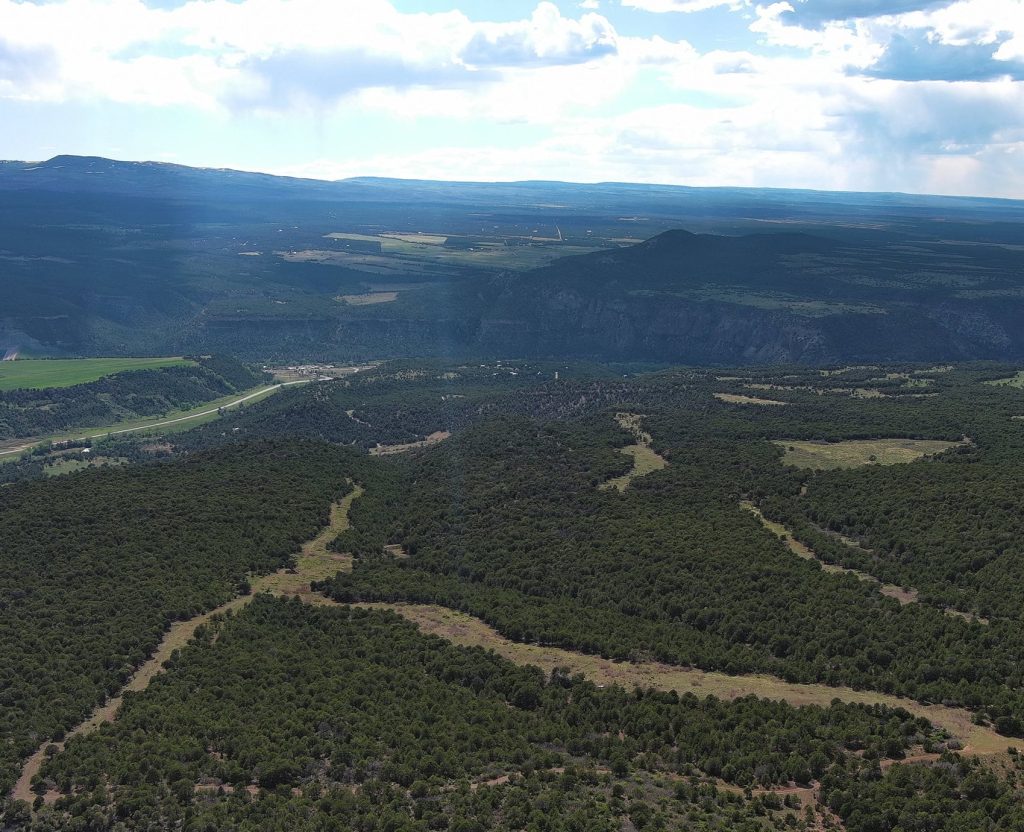Drive a high ridge above the Uncompahgre river, peer across the plateau, or scroll Google Earth over any Western Colorado country and you’ll spot them, broad, pale ovals and long rectangles stitched into dark piñon-juniper: “parks,” meadows, openings. Many of these are human-made, pulled from the woodland after World War II with a brutally simple tool: a ship’s anchor chain dragged between two giant bulldozers.
From shipyards to sage: the rise of “anchor chaining”
After 1945, the U.S. was swimming in heavy surplus, from airplanes to maritime hardware; managed and sold off by the War Assets Administration (WAA). The WAA liquidated huge inventories of military equipment and maritime property for civilian use, fueling a postwar market in heavy steel that made its way to ranches and public-lands projects across the West.
Range managers and agencies adopted a method that came to be known as chaining: stretch a naval surplus anchor chain between two large tractors and make one or two passes to topple piñon and juniper, scuff the soil, and seed grasses and forage for wildlife or livestock. This wasn’t folklore; agency and peer-reviewed sources describe how surplus Navy chains were rebranded as “Ely chains” and became the workhorse of rangeland treatments.
The Ely Chain: Steel Built for War, Re-purposed for the Range
Named after Ely, Nevada, where the technique was first deployed on a large scale, the Ely chain was no ordinary tool. These chains were designed to anchor warships against typhoons and open sea. After the war, they found a second life reshaping Western landscapes:
- Dimensions: Each link typically weighed 90 to 120 pounds, with diameters from 1.5 to 3 inches of solid steel. A chain might stretch 200 to 300 feet.
- Weight: Full lengths tipped the scale at 12 to 20 tons.
- Enhancements: Land managers often welded short railroad rails or steel bars across links, creating digging “teeth” that ripped roots and scarified soil.
- Operation: Two bulldozers dragged the chain across the slope, usually making two passes—first to topple woodland and scarify the earth, second to bury broadcast seed.
The Ely chain’s sheer bulk and flexibility made it uniquely suited to uneven, rocky country. What once secured naval fleets in the Pacific now carved out forage plots for cattle, sheep, and elk in the Colorado high country.
Why it happened here
Piñon-juniper woodlands naturally cover huge swaths of the Colorado Plateau and Western Slope. Postwar policy favored expanding forage and reducing fire risk; chaining and aerial/bulldozer seeding became common tools in that playbook. The Bureau of Land Management described the classic two-pass operation as the template for decades across the Intermountain West.
Colorado is very much part of that story. Research in Western Colorado explicitly documents chaining treatments and their ecological responses, and Forest Service guidance addressed how to design chaining projects for big-game winter range.
What it left on the land
Where chaining “took,” seeded grasses established open meadows; what ranchers and locals simply call parks. On satellite imagery, they show up as light, loosely connected openings against darker woodland; on scenic drives they appear as sudden pastures high on benches and mesas. Long-term studies note that chaining can change understories for decades, sometimes creating the very mosaic of browse and cover managers sought, other times trading complexity for uniformity.
The technique remains controversial, and modern projects often use different machinery (mastication, harrows) or emphasize smaller footprints. Still, agency documents and recent environmental assessments continue to reference chaining and Ely chain specs, proof that the postwar method didn’t just vanish; it evolved.
The wartime roots: steel, ships, and loss
It’s fitting, if a bit stark, that the chains that made our mountain “parks” were actually developed by the navy during a war. The U.S. Merchant Marine suffered the highest U.S. service casualty rate of the war; thousands of mariners were killed and 733 merchant ships were sunk by enemy action. Navy combat and weather losses were severe as well, three U.S. destroyers were lost in the December 1944 typhoon alone. Our wartime torrent of shipbuilding and loss created the postwar surplus that fed rangeland projects across the West and changed the landscape, perhaps forever, or at least most of our lifetime.
From Chains to Chippers: How Mastication Changed the Game
As land management philosophies evolved, so did the tools. Where bulldozers and anchor chains once thundered across the mesas, today’s range crews often rely on mastication — a method that uses powerful rotary shredders to grind woody vegetation into mulch right where it stands.
Unlike chaining, which uproots and drags entire trees across the landscape, mastication is a targeted and minimally disruptive approach. Each tree is chewed down to coarse chips and left on the soil surface, where it slowly decomposes. This mulch layer helps retain moisture, reduce erosion, and suppress invasive weeds — all critical advantages in a warming, drying West.
Why managers moved away from chaining
There are a few key reasons agencies and private landowners now favor mastication over chaining:
-
Precision – Modern hydraulic masticators can treat specific areas without disturbing adjoining ground or sensitive habitat.
-
Reduced erosion – Because the soil isn’t scraped bare, mastication leaves root systems and litter intact, stabilizing slopes and limiting un-natural accelerated erosion.
-
Fuel management – The chipped material decomposes slowly, reducing volatile fuel buildup while maintaining ground cover.
-
Wildlife and restoration goals – Mastication can be tailored to create a more natural patchwork of vegetation that mimics historic fire regimes and supports a mix of browse, cover, and nesting habitat.
The lasting legacy
Still, the ghosts of the old chains remain visible across Western Colorado — the straight, pale meadows that began as anchor-chain clearings now blend into the mosaic of rangeland, forest, and wildlife corridors. Mastication reflects the next chapter of that same story: humans continuing to shape the land, but with a lighter, and hopefully a bit more deliberate touch.


